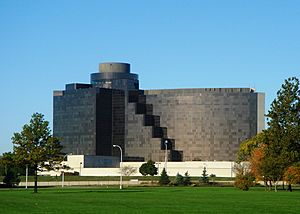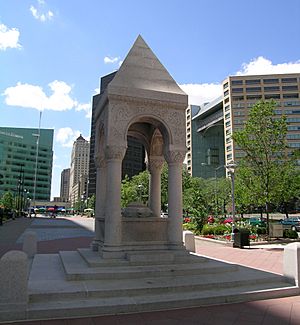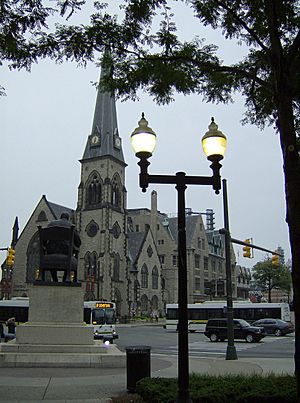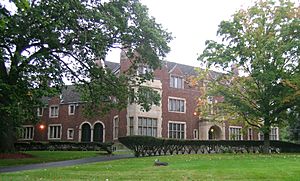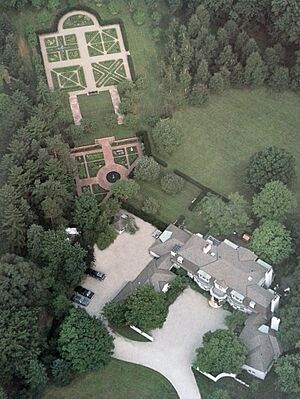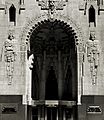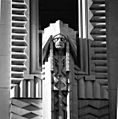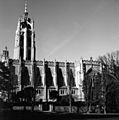Architecture of metropolitan Detroit facts for kids
The architecture of metropolitan Detroit is really special and catches the eye of architects and people who love old buildings. Detroit has one of the most famous skylines in the world. Its waterfront view shows off many different building styles. For example, the tall, pointy tops of One Detroit Center look like old Gothic churches, but they are actually modern. They remind us of the city's old Art Deco skyscrapers. These, along with the Renaissance Center, make Detroit's skyline unique.
Detroit's buildings are known as some of the best in the U.S. The city has one of the biggest collections of buildings from the late 1800s and early 1900s that are still standing. Because of money problems in the past, many of Detroit's tall buildings and other structures have been listed as "endangered landmarks" by the National Trust for Historic Preservation.
Even the areas around Detroit have cool modern buildings and some really old, fancy homes.
Contents
Skyscrapers
In the 1880s, famous architects like Wilson Eyre and firms like Donaldson & Meier started designing office buildings in Detroit. Before that, they mostly designed churches and homes in fancy neighborhoods. Many of these early tall buildings, with their detailed stone carvings, are still around today.
For example, the Wright-Kay Building (1891) was one of the first buildings to have an electric elevator! The Detroit Cornice and Slate Company Building (1897) has a very fancy front. The Globe Tobacco Building (1888) is another old commercial building that still stands. The Randolph Street Commercial Buildings Historic District has some of the oldest business buildings, with one dating back to the 1840s.
The United Way Community Services Building (1895), which is 12 stories tall, is Detroit's oldest existing skyscraper. The 10-story Hammond Building (1889) was considered the city's first skyscraper, but it's not there anymore.
Many important skyscrapers from the late 1800s and early 1900s were designed by architects like Daniel Burnham and firms like Smith Hinchman & Grylls. Burnham designed the Chrysler House (1912), the David Whitney Building (1915), and the Ford Building (1909). The Fyfe Building (1919) was designed by Smith Hinchman & Grylls and is now apartments.
Detroit has many historic buildings listed on the National Register of Historic Places. Some, like the Michigan Central Station (1913), are being restored. Ford bought this old train station in 2018 and is turning it into a big new development.
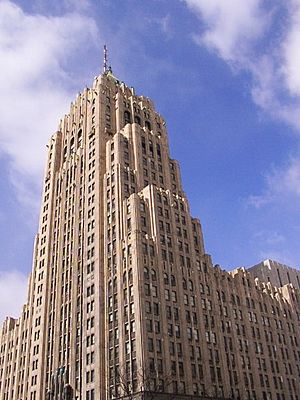

During the 1920s, a time called the "Roaring Twenties," Detroit's famous skyline really grew. The Westin Book-Cadillac Hotel (1924), designed by Louis Kamper, was the tallest hotel in the world when it opened!
Detroit is also famous for its Art Deco style buildings, built during the city's boom years in the 1920s. Architect Hugh Ferriss created drawings of new buildings for the city's skyline, which inspired many designs.
Albert Kahn Associates designed what is now Cadillac Place (1923) for General Motors. It has a Neo-Classical style. Kahn is sometimes called the "architect of Detroit."
The seven Fisher brothers, who owned the car company Fisher Body, gave architect Kahn a lot of money to design the "most beautiful building in the world." This became the Fisher Building (1927), which is so detailed it's been called the city's "largest art object." Its fancy lobby has a curved ceiling and is made with 40 different kinds of marble! The Fisher Building and Cadillac Place are important landmarks in Detroit's New Center.
Architect Wirt C. Rowland helped shape Detroit's skyline with his designs for the Buhl Building (1925), the Penobscot Building (1928), and the Guardian Building (1929). The Guardian Building is known for its colorful tiles made by Pewabic Pottery.
Tallest buildings
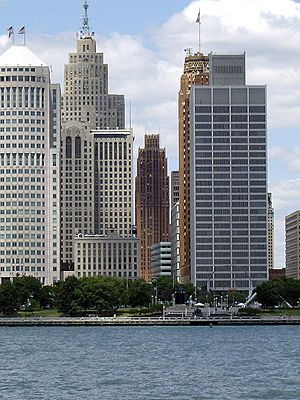
| Rank | Building | Height | Stories | Built | Notes | |
|---|---|---|---|---|---|---|
| 1 | Detroit Marriott at the Renaissance Center | 727 feet (222 m) | 73 | 1977 | ||
| 2 | One Detroit Center | 619 feet (189 m) | 43 | 1993 | ||
| 3 | Penobscot Building | 565 feet (172 m) | 47 | 1928 | ||
| T-4 | Renaissance Center Tower 100 | 522 feet (159 m) | 39 | 1977 | ||
| T-4 | Renaissance Center Tower 200 | 522 feet (159 m) | 39 | 1977 | ||
| T-4 | Renaissance Center Tower 300 | 522 feet (159 m) | 39 | 1977 | ||
| T-4 | Renaissance Center Tower 400 | 522 feet (159 m) | 39 | 1977 | ||
| 8 | Guardian Building | 496 feet (151 m) | 40 | 1929 | ||
| 9 | Book Tower | 475 feet (145 m) | 38 | 1926 | ||
| 10 | 150 West Jefferson | 455 feet (139 m) | 26 | 1989 |
Contemporary highlights
The Detroit area also has many modern skyscrapers. Minoru Yamasaki designed Detroit's One Woodward Avenue (1962). He later designed the famous World Trade Center towers in New York City, which looked similar. Today, Detroit's new skyscrapers stand next to its old, restored ones. One Detroit Center (1993) is a great example of modern architecture that still looks back at older styles.
The office space in Metro Detroit is one of the biggest in the country. The Renaissance Center and the Southfield Town Center are huge examples of modern skyscraper complexes. These are like "cities within a city" because they have many connected skyscrapers and different uses.
Building the Renaissance Center in Downtown Detroit started a new time for the city's architecture. In the 1970s, a group called Detroit Renaissance wanted to make the city more attractive. They asked architect John Portman to design a huge skyscraper complex called the Renaissance Center. Portman hoped this would encourage people to stay in the city.
Portman's design for the Renaissance Center helped make skyscraper hotels popular. Over the years, the Renaissance Center grew and joined the city's restored old skyscrapers to form the skyline we see today.
In 1924, Detroit's Westin Book-Cadillac Hotel opened as the world's tallest hotel. When the first part of the Renaissance Center was finished in 1977, Detroit got this title back. The Renaissance Center's main tower had a hotel that was the tallest in the world at the time. It also had the world's largest rooftop restaurant. Today, it's still the tallest all-hotel skyscraper in the Western Hemisphere.
In 1996, General Motors bought the entire Renaissance Center complex for its new headquarters. They spent $500 million to update it, including a $100 million renovation of the hotel. A new glass entrance called the Wintergarden (2003) was added, offering views of the waterfront and more shops.
The city also worked on a big project along the Detroit International Riverfront. They built a three-mile park along the east river. New casino hotels like the MGM Grand Detroit (2007) and Motor City Casino (2007) have also been built.
Beyond the city, suburbs like Southfield, Dearborn, and Troy also have modern towers. Southfield's modern buildings include the American Center (1975). Dearborn has the world headquarters of the Ford Motor Company. The Adoba Hotel Dearborn Detroit (1976) in Dearborn is a large, modern hotel with a curved design. Troy has many office buildings, including the 27-story Top of Troy (1975), which is shaped like a triangle.
Auburn Hills is home to the Chrysler Headquarters and Technology Center. This huge building has 5.3 million square feet of space. The SmithGroup designed the Chrysler Headquarters (1996) tower with golden glass and the pentastar emblem on top.
Future development
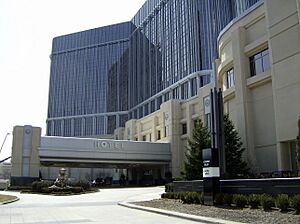
Between 1996 and 2006, downtown Detroit received over $15 billion in new investments. In 2011, Quicken Loans moved its main office to downtown Detroit, which was a big step for the city. They bought office buildings and are looking at new places to build. There are also plans for new homes and shops next to the Renaissance Center.
Many old buildings are being renovated into new homes and businesses. The Woodward Avenue Light Rail, which started in 2013, helps people travel between downtown and other areas.
In 2008, Detroit showed plans for a new Cadillac Centre, a $150 million complex with homes, entertainment, and shops. This futuristic building would be on Campus Martius Park, but it's currently on hold. Metro Detroit is a major place for architecture and engineering jobs in the U.S.
Landmarks and monuments

Detroit was founded in 1701, and it has some of the oldest churches in the U.S. Many of Metro Detroit's churches and cathedrals are beautiful buildings and are listed on the National Register of Historic Places. Churches were very important to the city's look after the Civil War.
The Ste. Anne de Detroit Catholic Church (1887) shows French influence with its Gothic style. It has the oldest stained glass in the city. The St. Joseph Church (1873/1883) is a German Catholic church known for its architecture and stained glass. The Old St. Mary's Church (1885) in Greektown Historic District has a Romanesque style. The Sweetest Heart of Mary (1893) is the largest Roman Catholic Church in Detroit.
The Cathedral of the Most Blessed Sacrament (1915) and the Cathedral Church of St. Paul (1911) are both Gothic style churches on Woodward Avenue. Sculptor Corrado Parducci's work can be seen in many of Detroit's churches. The Fort Street Presbyterian Church (1855) has a tall steeple that reaches 265 feet!
Many Polish immigrants settled in Detroit, leading to many beautiful churches in the Polish Cathedral style. These include St. Albertus (1885), St. Hedwig's (1915), and St. Florian's Church (1928). The St. Josaphat's (1901) has spires that line up with the Renaissance Center towers when you drive into the city.
Campus Martius
Detroit has many monuments and statues in its parks and along its streets. Campus Martius Park is a central park where Woodward and Michigan Avenues meet. It's a main gathering place for events. The park was removed in the 1900s to make way for more cars, but in 2004, the city brought it back. It has waterfalls, stages for music, and the Woodward Fountain, which can shoot water over 100 feet high! The Bagley Memorial Fountain is also nearby.
The Compuware World Headquarters building looks over Campus Martius Park, where you can also see the historic Michigan Soldiers' and Sailors' Monument from the Civil War.
Grand Circus
After a big fire in 1805 destroyed most of Detroit, a plan similar to Washington, D.C.'s layout was made. Detroit's wide avenues and roundabouts spread out from Grand Circus Park Historic District in the heart of the city's theater district.
Detroit's theaters are mostly around Grand Circus Park and along Woodward Avenue. The beautiful Fox Theatre (1928) is a famous landmark that was fully restored in 1988. The Orchestra Hall, home to the Detroit Symphony Orchestra, is also on Woodward. The Detroit Opera House (1922) faces Grand Circus Park. The park has old statues and fountains, including the Russell Alger Memorial Fountain (1921).
Neo-Renaissance and Neo-Classical
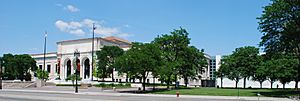
In the late 1800s, Detroit was called the Paris of the West because of its beautiful buildings and open public spaces. The Wayne County Building (1897) in downtown Detroit is a great example of Roman Baroque architecture mixed with Beaux-Arts style. It has bronze statues on top.
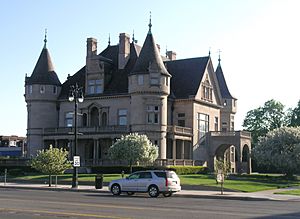
The French-American architect Paul Philippe Cret designed the Detroit Institute of Arts, which has a theater inside. Michael Graves designed the 2007 renovation and expansion of the museum, covering its outside in white marble. The Horace Rackham Education Memorial Building (1941) is also a beautiful Neo-Classical building.
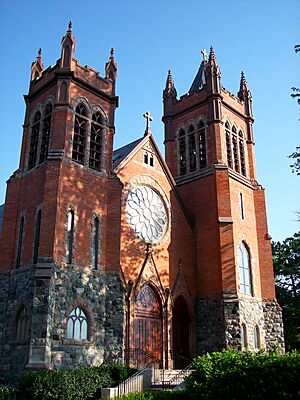
The Detroit area has lighthouses, yacht clubs, and many unique monuments. The Detroit Public Library (1921) and the James Scott Memorial Fountain on Belle Isle were both designed by Cass Gilbert. Frederick Olmsted, who designed New York City's Central Park, designed Detroit's 982-acre Belle Isle park. Sculptures by Marshall Fredericks, like the Spirit of Detroit, can be seen all over the area. Corrado Parducci's sculptures decorate many famous Detroit buildings, including the Guardian Building and the Fisher Building.
Important landmarks outside the city include the French Gothic St. Paul on the Lake Catholic Church (1899) in Grosse Pointe Farms, and the Cranbrook Educational Community in Bloomfield Hills.
Eliel Saarinen designed the Cranbrook Educational Community. His son, Eero Saarinen, designed the GM Technical Center in Warren, Michigan. Sculptor Carl Milles has many works in Metro Detroit, including fountains at Cranbrook.
Residential architecture
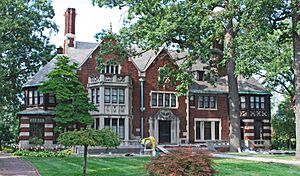
Downtown Detroit has tall apartment buildings, but most of the city has shorter buildings and single-family homes. Neighborhoods built before World War II have wooden and brick houses, with bigger brick homes in middle-class areas and fancy mansions in historic districts and nearby suburbs. The oldest neighborhoods are along Woodward and Jefferson Avenues.
Tall residential buildings are found along the Detroit International Riverfront and in the Palmer Park area. Ludwig Mies van der Rohe designed a residential area called Lafayette Park (1958–1965) with three tall buildings and over 200 townhouses. This is the largest group of buildings designed by Mies van der Rohe in the world.
Some of the oldest working-class neighborhoods include Corktown, settled by Irish immigrants. The Southwest part of the city is seeing new homes and condos, especially around the Mexicantown area.
Detroit's historic neighborhoods have amazing homes from the "Gilded Age" (late 1800s). Many old mansions have been restored, like those in Midtown's Brush Park. The David Whitney House (1894) is a beautiful mansion made of jasper stone and is now a restaurant.
The Arden Park-East Boston historic district is known for mansions built by wealthy business owners in the 1910s and 1920s, including the Dodge Brothers and Fred Fisher. The nearby Boston-Edison neighborhood has homes designed by Albert Kahn, and houses owned by famous people like Henry Ford.
Detroit also has works by Frank Lloyd Wright, a very famous architect. He designed several homes in the Detroit area, including the Dorothy H. Turkel House.
The mansions in metropolitan Detroit are some of the grandest in the country. Meadow Brook Hall (1929) in Rochester Hills is a huge 110-room mansion, the fourth largest in the U.S. It's open to the public. The suburbs of Grosse Pointe and Bloomfield Hills have many grand mansions. Albert Kahn designed the Edsel and Eleanor Ford House (1927) in Grosse Pointe, which you can visit.
The Russell A. Alger Jr. House (1910) is an Italian Renaissance style mansion that now serves as the Grosse Pointe War Memorial. The Cranbrook House in Bloomfield Hills is also a famous estate.
Photo gallery
Skyscrapers
|
|---|
Landmarks
|
|---|
Monuments
|
|---|
Architectural sculpture
|
|---|
See also
 In Spanish: Arquitectura de Detroit para niños
In Spanish: Arquitectura de Detroit para niños






